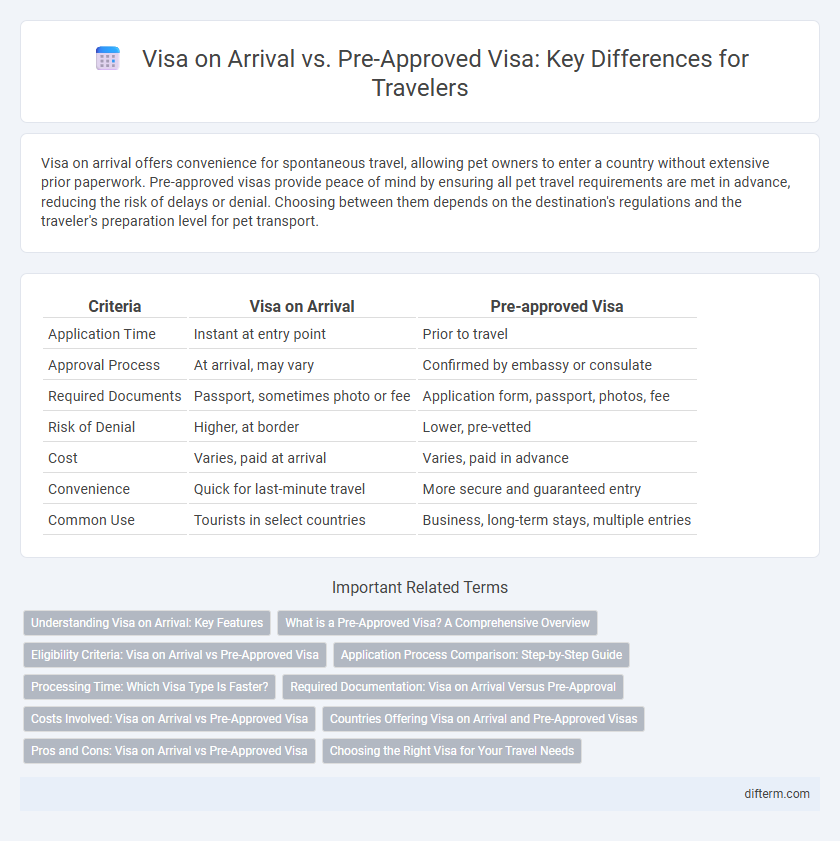Visa on arrival offers convenience for spontaneous travel, allowing pet owners to enter a country without extensive prior paperwork. Pre-approved visas provide peace of mind by ensuring all pet travel requirements are met in advance, reducing the risk of delays or denial. Choosing between them depends on the destination's regulations and the traveler's preparation level for pet transport.
Table of Comparison
| Criteria | Visa on Arrival | Pre-approved Visa |
|---|---|---|
| Application Time | Instant at entry point | Prior to travel |
| Approval Process | At arrival, may vary | Confirmed by embassy or consulate |
| Required Documents | Passport, sometimes photo or fee | Application form, passport, photos, fee |
| Risk of Denial | Higher, at border | Lower, pre-vetted |
| Cost | Varies, paid at arrival | Varies, paid in advance |
| Convenience | Quick for last-minute travel | More secure and guaranteed entry |
| Common Use | Tourists in select countries | Business, long-term stays, multiple entries |
Understanding Visa on Arrival: Key Features
Visa on arrival offers travelers the convenience of obtaining entry authorization directly at the port of entry, eliminating the need for advance application. This option typically requires travelers to meet specific eligibility criteria, present required documents, and pay visa fees upon arrival. Understanding key features such as application processes, eligible destinations, and validity periods helps travelers choose between visa on arrival and pre-approved visas for seamless international travel.
What is a Pre-Approved Visa? A Comprehensive Overview
A pre-approved visa is an official authorization granted by a country's immigration authorities prior to travel, allowing entry without requiring a visa upon arrival. This type of visa often involves an application process where travelers must submit documents and receive approval before departure, ensuring smoother entry and avoiding potential delays at border control. Pre-approved visas are commonly used for countries with stricter immigration policies or where security screening is prioritized.
Eligibility Criteria: Visa on Arrival vs Pre-Approved Visa
Visa on arrival eligibility typically requires travelers to hold a valid passport from a country with bilateral agreements, proof of onward travel, and sometimes vaccination certificates, with fewer documentation demands upfront. Pre-approved visas demand applicants submit detailed documentation such as invitation letters, financial proof, and travel itineraries before arrival, often involving longer processing times. Eligibility for pre-approved visas is generally broader but more stringent, whereas visa on arrival favors spontaneous travel but is limited to specific nationalities and entry points.
Application Process Comparison: Step-by-Step Guide
Visa on arrival requires travelers to complete a simplified application at the entry point, often involving minimal paperwork and immediate verification, suitable for spontaneous trips. Pre-approved visa demands submission of detailed documents online or at an embassy, undergoing thorough background checks and approval before departure, ideal for planned travel. Understanding these step-by-step differences ensures efficient preparation and compliance with destination-specific immigration policies.
Processing Time: Which Visa Type Is Faster?
Visa on arrival typically offers faster processing times, often allowing travelers to receive entry permits within minutes to a few hours upon arrival, making it ideal for spontaneous trips. Pre-approved visas generally require several days to weeks for application review, as they involve background checks and document verification before travel. Choosing visa on arrival expedites entry but may carry risks if requirements are not met, whereas pre-approved visas guarantee clearance but demand longer preparation.
Required Documentation: Visa on Arrival Versus Pre-Approval
Visa on arrival typically requires a valid passport, recent passport-sized photographs, proof of onward travel, and sufficient funds, whereas pre-approved visas demand comprehensive documentation such as completed application forms, invitation letters, detailed travel itineraries, and sometimes bank statements submitted well before departure. Travelers opting for visa on arrival benefit from minimal paperwork and faster processing but may face unpredictability upon arrival, while pre-approved visas provide assured entry with thorough verification but involve longer processing times. Understanding the specific country's regulations on required documentation ensures compliance and smooth entry during international travel.
Costs Involved: Visa on Arrival vs Pre-Approved Visa
Visa on Arrival typically involves higher fees due to service charges and potential currency exchange costs, making it less economical for budget travelers. Pre-Approved Visas often have fixed application fees paid in advance, reducing unexpected expenses and providing clarity on total visa costs. Travelers should consider hidden expenses such as agent fees or airport surcharges associated with Visa on Arrival when comparing overall costs.
Countries Offering Visa on Arrival and Pre-Approved Visas
Countries offering visa on arrival include Thailand, Indonesia, and Kenya, allowing travelers to obtain entry permits directly at the airport with minimal paperwork. Pre-approved visas, typically required by nations like the United States, Australia, and India, demand travelers secure permission before departure, often through online applications or consulates. Understanding each country's specific visa policies ensures smoother international travel planning and compliance with immigration regulations.
Pros and Cons: Visa on Arrival vs Pre-Approved Visa
Visa on Arrival offers flexibility and convenience for spontaneous travelers, eliminating the need for lengthy pre-travel paperwork, but it may result in longer wait times at entry points and higher risk of denial. Pre-Approved Visas provide assurance of entry and faster processing upon arrival, reducing stress and unpredictability, though they require prior planning and comprehensive documentation submission. Both options impact travel itineraries significantly, with Visa on Arrival catering to last-minute plans and Pre-Approved Visas benefiting those with well-organized trips.
Choosing the Right Visa for Your Travel Needs
Selecting between visa on arrival and pre-approved visa depends on travel destination, duration, and purpose. Visa on arrival offers convenience and flexibility for short stays but may involve longer wait times and potential entry denial. Pre-approved visas require advance application, offering assurance and smoother entry, ideal for longer trips or business travel.
visa on arrival vs pre-approved visa Infographic

 difterm.com
difterm.com